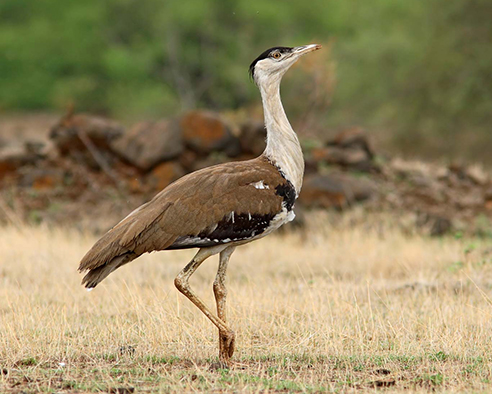Biodiversity & Environment
Great Indian Bustards
- 19 Apr 2021
- 3 min read
Why in News
Recently, a group of hunters shot down two Great Indian Bustards (GIBs) in a protected area of southern Punjab’s Cholistan in Pakistan.
Key Points
- About:
- The Great Indian Bustard (GIB), the State bird of Rajasthan, is considered India’s most critically endangered bird.
- It is considered the flagship grassland species, representing the health of the grassland ecology.
- Its population is confined mostly to Rajasthan and Gujarat. Small populations occur in Maharashtra, Karnataka and Andhra Pradesh.
- The bird is under constant threats due to collision/electrocution with power transmission lines, hunting (still prevalent in Pakistan), habitat loss and alteration as a result of widespread agricultural expansion, etc.
- Protection Status:
- International Union for Conservation of Nature Red List: Critically Endangered
- Convention on International Trade in Endangered Species of Wild Fauna and Flora (CITES): Appendix1
- Convention on Migratory Species (CMS): Appendix I
- Wildlife (Protection) Act, 1972: Schedule 1
- India’s Concerns:
- The grassland habitat in the Cholistan desert, where the GIBs were killed, is very similar to the habitat in Rajasthan’s Desert National Park (DNP), where the GIB’s last remnant wild population is found.
- DNP is situated near the towns of Jaisalmer and Barmer, forming a part of the mighty Thar desert.
- It was declared as a National Park in 1981 to protect the habitat of the Great Indian Bustard.
- As Rajasthan shares the international border with Pakistan's Sindh and Punjab provinces, the birds will become an easy prey for the gun-toting poachers there.
- The hunting of the rare bird will not only drastically reduce India’s GIB population, but will also affect the desert ecosystem.
- The grassland habitat in the Cholistan desert, where the GIBs were killed, is very similar to the habitat in Rajasthan’s Desert National Park (DNP), where the GIB’s last remnant wild population is found.
- Government’s Initiatives:
- It is kept under the species recovery programme under the Integrated Development of Wildlife Habitats of the Ministry of Environment, Forests and Climate Change (MoEFCC).
- The MoEFCC has also launched a program called ‘Habitat Improvement and Conservation Breeding of Great Indian Bustard-An Integrated Approach’.
- The objective of the programme is to build up a captive population of Great Indian Bustards and to release the chicks in the wild for increasing the population.
- Rajasthan government has launched ‘Project Great Indian Bustard’ with an aim of constructing breeding enclosures for the species and developing infrastructure to reduce human pressure on its habitats.





